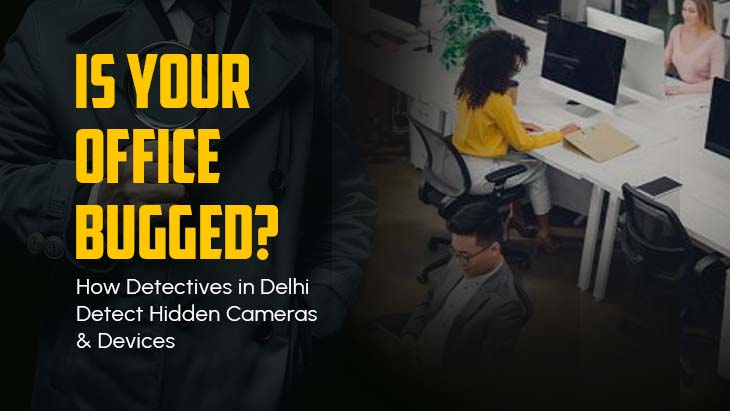In the 21st century, information is one of the most valuable assets for the corporate world. Companies spend years making plans, building networks, and keeping their data safe. But what if all the work you’ve done is going to the wrong people without you knowing? It’s not just movies anymore that have cameras, microphones, and other spying tools. They are real, easy to get to, and worryingly simple to set up in your office.
Thanks to advancements in IT, finance, and countless startup endeavors, entrepreneurial endeavors in Delhi are now growing faster than ever. With this rapid growth comes increased scrutiny from competitors and disgruntled employees, both of whom can easily access and utilize small spying apparatuses to acquire sensitive intel. Businesses are often in the dark about being eavesdropped on until the damage is done, whether that be financial loss or a damaged reputation.
This is precisely where the professional Private Investigators in Delhi come in. With multiple years in the field and the use of specialized apparatus, they are equipped to execute Tactical Surveillance Counter Measures (TSCM). This is a detailed and systematic approach used to locate and neutralize eavesdropping devices. Let’s analyze the three questions which can be posed about this matter. Why do offices get bugged, what is the professional approach to this problem and what are the risks involved in this type of activity.
Why Would Someone Want to Bug Your Office?
It might seem extreme, but spying on businesses is not uncommon in India. There is a lot of competition among businesses in Delhi, especially those in fields with a lot at stake. Here are some common reasons why people want to spy on offices without being seen:
- Spying on businesses: Your competitors might want to see your plans for your products, your client lists, or your money plans early on.
- Internal Threats: Current or former employees who are angry may leave behind devices to keep an eye on things.
- People can use recorded conversations that were private to get money through fraud or blackmail.
- People who are in a lawsuit might try to record private conversations.
- Unauthorized Monitoring: People who work for you, like landlords, maintenance staff, or even people who aren’t supposed to be there, can set up spy equipment without anyone noticing.
In short, any business that handles private, financial, or strategic information could be at risk.
What Do Hidden Devices Look Like?
The hardest thing about spy gear is that it looks like other things. You might not see a device even if you look right at it. Detectives in Delhi often see these common disguises:
- Cameras that are part of smoke detectors, clocks, or lights
- Hidden listening devices in chargers, pens, or wall outlets
- GPS trackers on work cars
- Wireless transmitters in conference rooms
- Small microphones that are hidden behind wall panels or under desks
These spy devices or gadgets are small, wireless, and sometimes run on batteries, so they don’t always need to be plugged in. Without professional tools, this makes them very hard to find.
Signs Your Office Might Be Bugged
- Like strange noises or static when talking on the phone.
- Signals from Wi-Fi, Bluetooth, or the radio that aren’t normal.
- The batteries in your office devices run out faster.
- Things that aren’t where they should be or things that someone else put there without your permission.
- Employees see technicians they don’t know coming to work for vague reasons, like fixing things or doing maintenance.
These signs don’t mean your office is definitely bugged, but they should make you want to hire a professional to check it out.
How Delhi Detectives Find Devices That Are Hidden
TSCM detectives use step-by-step method to find and stop threats to privacy. This is how they usually do their jobs:
1. Physical Inspection
The first thing to do is search the whole body. Detectives search the office, from conference rooms to executive cabins, for anything that seems off or has been changed or looks suspicious. They check also that people use every day, like smoke detectors, plugs, and picture frames, very carefully.
2. Scanning with Radio Frequency (RF)
Most hidden devices send information over radio waves.RF scanners help detectives find suspicious signals. These scanners can see signals that other equipment can’t, even if they’re weak.
3. Non-Linear Junction Detector (NLJD)
This high-tech tool can find electronic parts that could be hidden in walls, furniture, or ceilings, even if the bug isn’t sending anything. NLJDs are great for finding devices that aren’t being used.
4. Thermal Imaging
Some spy tools get hot when you use them. Thermal imaging cameras help detectives to find hidden devices or spy gadgets that give off strange heat signatures.
5. Looking at the spectrum
A spectrum analyzer helps you find weird signals in the electromagnetic spectrum. This helps police figure out which signals are normal office signals (like Wi-Fi) and which ones might be dangerous.
6. Checking the Phone and the Network
You can also digitally bug someone. Investigators look for viruses, spyware, or apps that shouldn’t be on office computers. They could also check network traffic for signs that someone is stealing data.
7. Covert Detection Tools
In sensitive cases, detectives use things like hidden camera lens detectors. These tools bounce infrared light off a camera lens, which makes it possible to see it even when it is hidden.
8. Report and Neutralization
After the sweep, the agency sends out a full report of what they found. If devices are found, they neutralize the devices and keep them safe for proof in case they need to be used in court.
Why Hire Detectives Instead of Doing It Yourself?
You might be wondering why you can’t just buy a detector online and check the office yourself. You can find DIY tools, but they don’t usually work as well as tools and skills that professionals use. This is why you should hire professional detectives in Delhi:
- Job-specific training: Detectives know where and how to find hidden gadgets.
- Advanced Tools: It’s not easy for most people to get professional tools like NLJDs or spectrum analyzers.
- Experience with Patterns: Experts know how corporate spies work and can spot small warning signs.
- Confidentiality: Hiring professionals makes sure that the sweep is private and doesn’t give criminals a heads up.
If you find surveillance devices, detectives can help you file complaints and keep the evidence safe.
Real-World Scenarios in Delhi
Some of the most common reasons businesses in Delhi hire detectives to look for bugs are:
Watching the Boardroom: A top consulting firm thought that their competitors knew about their pitches ahead of time. A search found a hidden listening device in the conference room light fixture.
The IT company found out that their project data was getting out because employees were spying on each other. A disgruntled ex-employee hid a camera in a wall clock.
Property Disputes: A family that runs a business found a voice recorder in the air conditioning vent of their office. It had been put there during a legal battle with family members.
These cases show that no office is safe and that it is often cheaper to do preventive sweeps than to fix things after a breach.
Preventive Steps to Protect Your Office
The best way to go is to hire a professional, but companies can do things every day to lower their risks:
- Limit Access: Only let certain people into sensitive rooms and keep track of who comes in.
- Check places where people often hide, like sockets, ceilings, and furniture on a regular basis.
- Network Security: To keep your Wi-Fi and devices safe, use strong passwords and encryption.
- Teach your workers to report anything strange or suspicious that they see or hear.
- Set up regular TSCM checks with professional detectives in Delhi to do routine sweeps.
The Cost of Ignoring the Threat
Some businesses are afraid to do bug sweeping services because they don’t think it’s necessary or because it costs too much. But think about the risks:
- Strategies that got out: Competitors getting ahead by months.
- Privacy Violation: Private talks about money made public.
- Loss of Reputation: If hackers get into your office, your clients might not trust you anymore.
- Legal Issues: If private client information gets out, people could sue you.
On the other hand, hiring detectives for a professional sweep is a small cost that can help keep your business safe.
In Conclusion
Information is both a strength and a weakness in Delhi’s fast-paced business world. More people than you might think have hidden cameras, and they can be very bad.
If you’ve seen strange signs or just want to feel safe, it’s a good idea to hire a professional detective agency in Delhi to do a bug sweep. Detectives have the skills, equipment, and privacy to find threats and keep your workplace safe.
You can’t just lock doors and protect servers; you also need to make sure that no one is taking your future without you knowing it.






